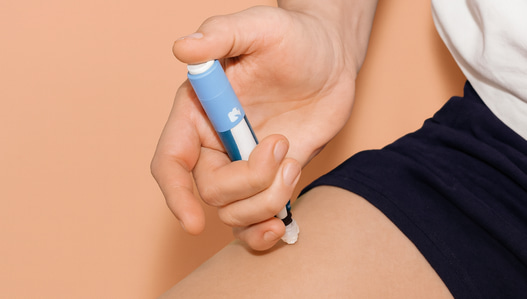Quick Summary
Mounjaro doses are slowly increased to make the treatment more effective and reduce its side effects. Doctors increase the doses every 4 weeks so that your body can safely adjust to the medication.
How Mounjaro Helps Your Body
Mounjaro works by copying the natural hormones in your body that are responsible for controlling appetite, blood sugar and digestion. These hormones are the GLP-1 and GIP.
Other treatments like Ozempic and Wegovy only target only one hormone, but Mounjaro targets both. That is the reason Mounjaro is more powerful for managing blood sugar and effective weight loss.
See our How Long Does Mounjaro Take to Work? A Comprehensive Guide to Expectations for more details.
Why Do You Need to Slowly Increase Your Dose?
<5 class=”h3″>Reduce stomach side effects
Mild GI issues are common when starting Mounjaro. Symptoms like nausea, bloating, diarrhoea, or constipation happens. That is why raising your dose slowly will help you keep your treatment safe and effective.
You will begin with a 2.5 mg dose, and every 4 weeks, your doctor may increase it gradually until you reach your ideal maintenance dose.
See our article about How Long Do Mounjaro Side Effects Last? for more safety tips.
Helping your body adjust
Your body needs time to adjust to each new dose because slow increase helps:
- Keep your blood sugar steady
- Minimise nausea
- Metabolism naturally adjusts
- Makes dose changes easier on your body
Supporting steady weight loss
Slow dose increase helps your body handle higher doses with lower side effects, which results in a more effective treatment.
A Higher dose can lead to more weight loss, but the step by step approach makes it safer and easier to maintain. It also helps your body build healthy habits that maintain your progress.
Learn more in How Much Weight Can You Lose on Mounjaro In A Month?
Typical Mounjaro Dosage Schedule
Adjusting your Mounjaro dose will be based on how your body adjusts and your health goals. Check below step by step schedule used in the UK:
| Stage | Mounjaro Dose | Duration (Approx.) | Purpose |
| Starting | 2.5 mg | First 4 weeks | Help your body get used to the medicine |
| Step 2 | 5 mg | Next 4 weeks | Starts control in appetite and blood sugar |
| Step 3 | 7.5 mg | Next 4 weeks | Supports more weight loss and better sugar control |
| Step 4 | 10 mg | Next 4 weeks | Strengthens and maintain the results |
| Step 5 | 12.5 mg | Next 4 weeks | Optional step before the final dose |
| Step 6 | 15 mg | Maintenance dose | Usual long-term dose |
Your doctor will guide you through these stages safely based on your progress.
See our Mounjaro Dosage Chart: Weekly Dosing Guide for Weight Loss & Diabetes for detailed UK titration schedules.
NHS vs Private Prescribing Differences
- NHS: Right now, Mounjaro is gradually being rolled out only for treatment of type 2 diabetes.
- Private clinics: Mounjaro can be prescribed by private clinics including Harley Street Skin Clinic for weight loss.
Private prescriptions also involve ongoing monitoring and tailored support managing dose increase.
Effective & professional doctor-led Mounjaro at our central London clinic
Verified Before & After
Verified Before & After
Safety Tips and Monitoring
Mounjaro provides benefits but it is important to carefully follow your doctor’s advice when increasing dose.
When Mounjaro may not be suitable
You should not use Mounjaro if:
- Personal or family history of thyroid cancer, MEN-2 syndrome.
- A history of pancreatitis or serious digestive issues
- Severe stomach or gut problems, especially if you already have issues in slow digestion.
Why doctor supervision matters
Do not increase your dose on your own. Doctors will slowly increase the doses based on your tolerance, medical history and response.
Regular check-up help your doctor to:
- Track your weight, appetite and side effects.
- Safely adjust your dose
- Prevent complications from sudden dose increase.
- Get tips on diet and hydration for each new stage.
What if you increase the dose too quickly?
Increasing your dose too fast can cause:
- Strong nausea or vomiting
- Dehydration from upset stomach
- Tiredness and dizziness
- Blood sugar changes
If this happens, your doctor may pause your treatment or lower your dose until your body feels better.
Managing Side Effects During Dose Increases
Some side effects are common in the first few weeks using Mounjaro. Here is how to manage them safely and stay on track:
Diet and Lifestyle Tips
- Try small, frequent meals and stay clear of greasy or heavy food.
- Drink plenty of water or herbal tea throughout the day.
- Stick to bland foods like crackers, toast, or plain rice because they are gentle on your stomach.
- Skip sodas and alcohol, because they can worsen bloating and indigestion.
- Get enough rest , fatigue can occur temporarily as your body adjusts.
See our What to Eat on Mounjaro: 10 Healthy Choices guide for a full meal plan.
When to delay increasing your dose
If the side effects like nausea, vomiting or diarrhoea do not go away after a few days after the dose increase, your treatment may be paused or delayed by your doctor.
This will give your body enough time to adjust safely. This will also help many users continue comfortable treatment instead of stopping completely.
Real Patient Example
Case study: Slow and steady progress
A female UK patient started using Mounjaro at 2.5 mg and felt less cravings in a few weeks. She then moved up to 5 mg and noticed clear weight changes without major side effects.
By the time she reached 10 mg, she lost over 10% of her starting weight in three months, resulting in better energy and confidence.
This only shows how gradual increase in dose can result in significant results while keeping the treatment safe.
See our Mounjaro Weight Loss by Week: Your Weekly Progress Guide for real-world progress insights.
Patient experiences
Many patients share same experiences about using Mounjaro:
“I started slow and never felt sick, it was easy to manage.”
“Each dose increase got easier as my body adjusted.”
“Taking my time greatly helped me stay consistent and results were great!”
FAQs
- How often should I increase my Mounjaro dose?
Usually every 4 weeks, your doctor will decide what is best for you.
- What if I miss a dose increase?
Don’t worry — simply stay on your current dose until your next scheduled review. Never double up to catch up.
- Can I stay on a lower dose long-term?
Yes. Some patients remain on a lower maintenance dose if it provides good results and manageable side effects.
- What happens if I increase too fast?
You may experience stronger side effects like nausea or vomiting. Always let your doctor guide dose changes to prevent discomfort.
- How long should I stay on each dose before increasing?
Typically four weeks, but your clinician may recommend longer if your body needs more time to adapt.
- What if side effects worsen after a dose increase?
Pause escalation, stay hydrated, and contact your doctor for advice. You may be advised to return to the previous dose temporarily.
- Can I skip a dose increase and stay at my current level?
Yes, if your current dose works well for you, there’s no rush to move up. Your prescriber will guide you based on your results.
Key Takeaways
- Mounjaro works best when doses are increased gradually under medical supervision.
- Each step allows your body to adapt safely, reducing side effects.
- The standard UK schedule begins at 2.5mg and rises every 4 weeks up to 15mg.
- Slow titration leads to better tolerance and longer-lasting results.
- Always follow professional guidance and report any ongoing side effects.
Reserve a mounjaro appointment
One of our experts will be more than happy to answer any questions you have.
Book AppointmentEmma Ashwood
★★★★★
Very informative.
21st November 2025
Dr Hasib Ur-Rub
★★★★★
The best
22nd November 2025
Harriet Steel
★★★★★
I had a fantastic experience at the Harley Street Skin clinic - everyone was super helpful and constructive
28th November 2025












